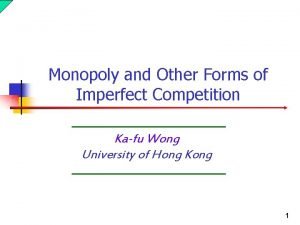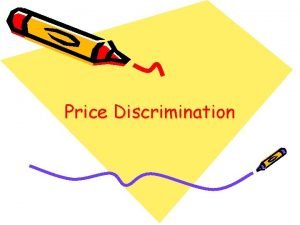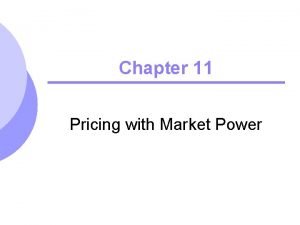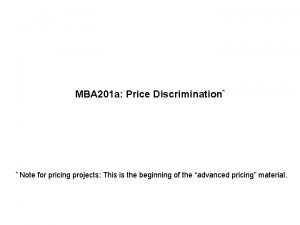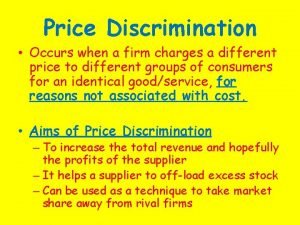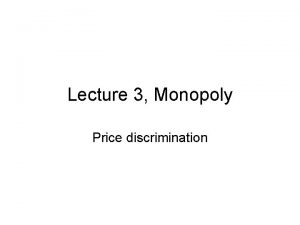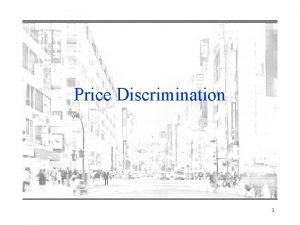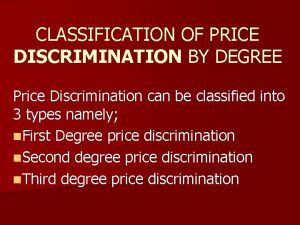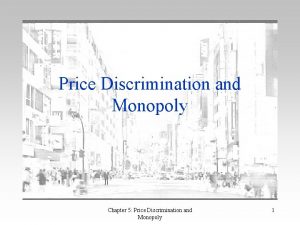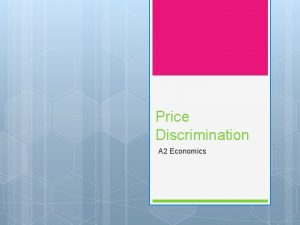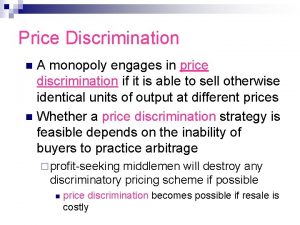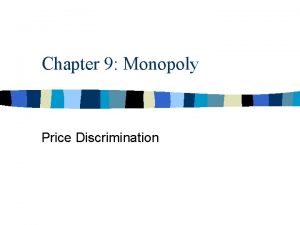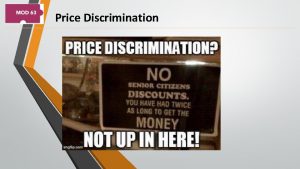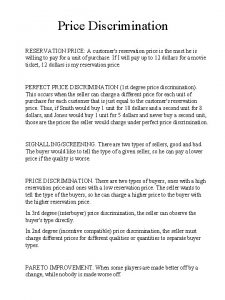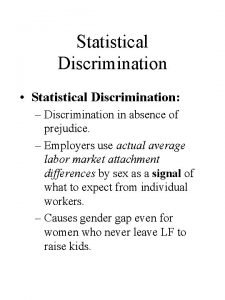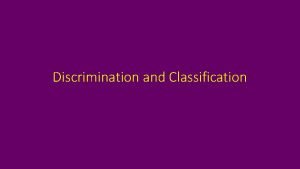What is Price Discrimination Price discrimination involves market
















- Slides: 16

What is Price Discrimination? • Price discrimination involves market segmentation • Practiced by monopolists or any firm with price setting power • Does not occur in perfectly competitive markets • A firm price discriminates when it charges different prices to different consumers for reasons that do not reflect cost differences • This involves extracting consumer surplus from buyers and turning this into additional revenue and profit • A business is exploiting the fact that consumers have a different willingness and ability to pay for goods and services

Conditions Required for Price Discrimination • The firm must have some price-setting power in at least one market (I. e. operating in an imperfectly competitive market) • There must be at least two consumer groups a with different price elasticity of demand • The firm should be able to identify consumers in each group, and set prices differently for consumers in the groups (requires sufficient information) • The firm must prevent consumers in one group selling to consumers in the other (no market arbitrage or market seepage)

1 st Degree (Perfect) Price Discrimination • Involves perfect segmentation of the market by the supplier • Every customer is charged his or her “willingness to pay” • So there is no consumer surplus in the transaction • The monopolists’ demand curve becomes the marginal revenue curve, i. e. you do not have to lower the price to the higher value customers in order to sell more! • More goods are sold; but price is higher to some customers • Total output is higher than under normal profit-maximization

1 st Degree Price Discrimination Price P 1 AC = MC Marginal Revenue Q 1 AR (Market Demand) Quantity Normal profit maximising price and output is P 1 and Q 1 (where marginal revenue meets marginal cost)

1 st Degree Price Discrimination – Equilibrium Output Price Pmon AC = MC AR= market demand MR Qm Qe Quantity Normal profit maximising price and output is P 1 and Q 1 (where MR=MC) With perfect price discrimination, output may rise to Qe where MC meets the demand curve

Extracting the Consumer Surplus Price (P) P 2 P 1 AC = MC P 3 MR Q 2 Q 1 Q 3 AR (Market Demand) Quantity of Output (Q)

Extracting the Consumer Surplus Price (P) Equilibrium output with perfect price discrimination – the monopolist will sell an extra unit providing that the next unit adds as much to revenue as it does to cost P 2 P 1 AC = MC P 3 MR Q 2 Q 1 Q 3 AR (Market Demand) Quantity of Output (Q) Each consumer is charged what they are willing to pay – the market is segmented and the seller aims to extract the consumer surplus and turn this into revenue and extra (marginal) profit

Examples of 1 st Degree Discrimination • First degree discrimination takes place when bartering exists between buyers and sellers • The bid and offer system in the housing market where potential home buyers put in an offer on an individual property • Negotiating prices with dealers for second hand cars • Haggling for the price of a hotel room • Antiques fairs and car boot sales!

Excess Capacity Pricing? • Excess capacity pricing exists when sellers try to off-load their spare output to buyers • Examples – Cheaper priced restaurant menus at lunchtime – Cinema and theatre tickets for matinees – Hotels offering winter discounts – Car rental firms reducing prices at weekends • Not always the case that prices are lower if consumers delay their purchases – Advance discounts on season tickets for soccer clubs – Discounts for early booking of package holidays

3 rd Degree : Market Separation • Separate markets based on some identifiable characteristic • Monopolist seeks to maximize profits in each sub-market • Sell additional output in elastic market (lower price) • Reduce sales in inelastic market (increase price) • Prevent resale of the good or service • Examples of Market Separation / Segmentation – Discounts to Seniors / Senior Citizens – Different prices for students and adults for bus travel – Gender pricing in some bars/night clubs

Third Degree Price Discrimination Market A Market B Price ARa MRa Quantity MRb ARb Quantity

Third Degree Price Discrimination Market A Market B Price MC=AC ARa MRa Quantity MRb ARb Quantity

Third Degree Price Discrimination Market A Market B Price Pb Pa MC=AC ARa MRa Quantity MRb ARb Quantity

Third Degree Price Discrimination Market A Market B Price Pa MC=AC ARa MRa Quantity MRb ARb Quantity

Third Degree Price Discrimination Market A Price Market B Profit from selling to market A – relatively elastic demand – lower price Pa MC=AC ARa MRa Quantity MRb ARb Quantity

Third Degree Price Discrimination Market A Market B Price Profit from selling to market A – relatively elastic demand – lower price Pb Profit from selling to market B – relatively inelastic demand – higher market price Pa MC=AC ARa MRa Quantity MRb ARb Quantity
 Upang mapatatag ang presyo sa pamilihan ipinatutupad ang
Upang mapatatag ang presyo sa pamilihan ipinatutupad ang Leader challenger
Leader challenger Objectives of segmentation
Objectives of segmentation Objectives of price discrimination
Objectives of price discrimination Monopoly perfect price discrimination
Monopoly perfect price discrimination Hurdle method of price discrimination
Hurdle method of price discrimination Price discrimination examples in real life
Price discrimination examples in real life Monopoly pricing prevents some mutually beneficial
Monopoly pricing prevents some mutually beneficial Second degree price discrimination graph
Second degree price discrimination graph Student discount price discrimination
Student discount price discrimination Versioning price discrimination
Versioning price discrimination Second degree price discrimination graph
Second degree price discrimination graph Perfect price discrimination
Perfect price discrimination Perfect price discrimination คือ
Perfect price discrimination คือ Hurdle model of price discrimination
Hurdle model of price discrimination Types of price discrimination
Types of price discrimination Price discrimination occurs when
Price discrimination occurs when





